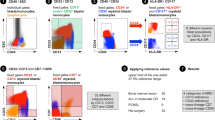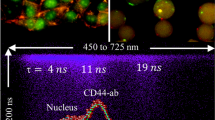Abstract
Progress in our understanding of the contribution of P-glycoprotein (P-gp)-mediated resistance to chemotherapy failure in haematological as well as solid tumours has been hampered by the lack of highly sensitive, reliable methods for the detection of P-gp function in fresh human tumour cells. The present study identifies the novel nucleic acid stain SYTO16 as a highly sensitive and specific dye to assess P-gp function. The effect of P-gp is expressed here as the ratio of dye fluorescence (RF) from cells incubated with dye with or without 2 microM of the P-gp inhibitor PSC 833. Using flow cytometric analysis, an RF of 0.9 was found for SYTO16 in the KB3-1 (P-gp-) and 1.6 in KB8 (P-gp+) cells. Three types of patients' cells were studied: (1) in haematopoietic CD34+ cells, which are known to express P-gp, the RF was 6.0 for SYTO16 compared with 2.5 for rhodamine 123 and 1.3 for daunorubicin (mean of five individuals); (2) in acute myeloid leukaemia cells, the RF for SYTO16 was 1.0 in P-gp- and 4.5 in P-gp+ samples; (3) for the first time, we have quantitated P-gp function in fresh human solid tumour (sarcoma) cells. We found, in a P-gp+ leiomyosarcoma, an RF of 16 for SYTO16 and 2.7 for daunorubicin. This means that complete inhibition of P-gp function in these sarcoma cells would lead to an increase of daunorubicin accumulation with 170% compared with 30% in the CD34+ cells. Next, we showed that SYTO16 could be fixed in nuclei by 3.6% formaldehyde treatment, allowing quantification of the nuclear fluorescence on cytospins by laser scanning microscopy. In conclusion, SYTO16 proved to have a combination of favourable properties: it can be excited at 488 nm and has large fluorescence enhancement upon binding to nucleic acids, allowing the use of low, nontoxic (< 10 nM) concentrations. Because the RF for SYTO16 is much higher than for daunorubicin, it can be applied for the determination of P-gp function in relatively small numbers of low-P-gp-expressing tumour cells by laser scanning microscopy. Individual sarcomas were found to have high P-gp function compared with CD34+ cells. This assay may be used to select patients for P-gp modulation protocols.
This is a preview of subscription content, access via your institution
Access options
Subscribe to this journal
Receive 24 print issues and online access
$259.00 per year
only $10.79 per issue
Buy this article
- Purchase on Springer Link
- Instant access to full article PDF
Prices may be subject to local taxes which are calculated during checkout
Similar content being viewed by others
Author information
Authors and Affiliations
Rights and permissions
About this article
Cite this article
Broxterman, H., Schuurhuis, G., Lankelma, J. et al. Highly sensitive and specific detection of P-glycoprotein function for haematological and solid tumour cells using a novel nucleic acid stain. Br J Cancer 76, 1029–1034 (1997). https://doi.org/10.1038/bjc.1997.503
Issue Date:
DOI: https://doi.org/10.1038/bjc.1997.503
This article is cited by
-
Absence of N-linked glycosylation does not affect plasma membrane localization of breast cancer resistance protein (BCRP/ABCG2)
Cancer Chemotherapy and Pharmacology (2005)
-
Functional characterization of minimal residual disease for P-glycoprotein and multidrug resistance protein activity in acute myeloid leukemia
Leukemia (2001)
-
Large populations of non-clonogenic early apoptotic CD34-positive cells are present in frozen-thawed peripheral blood stem cell transplants
Bone Marrow Transplantation (2001)
-
Flow cytometry counting of CD34+ cells in whole blood
Nature Medicine (2000)



